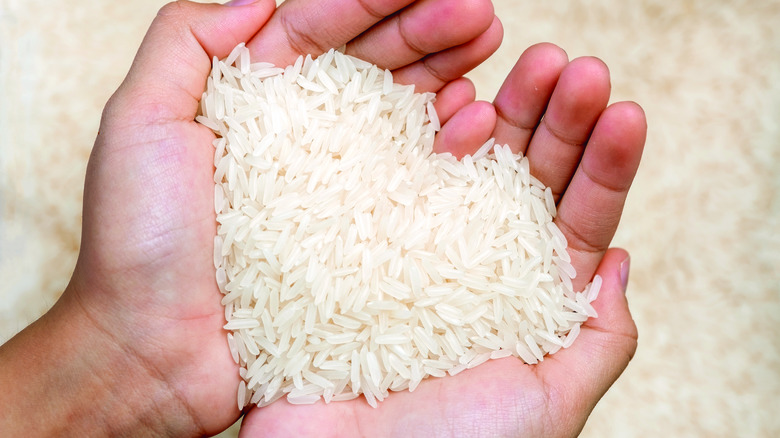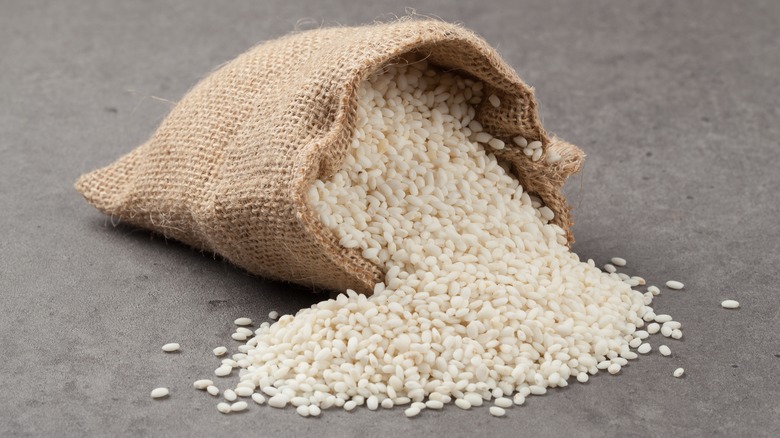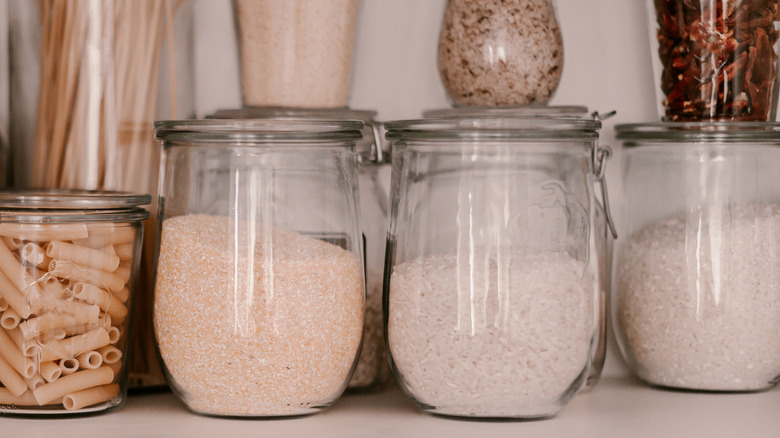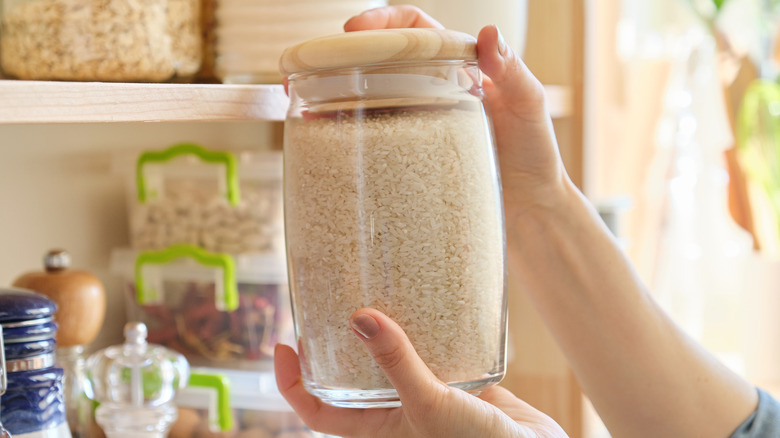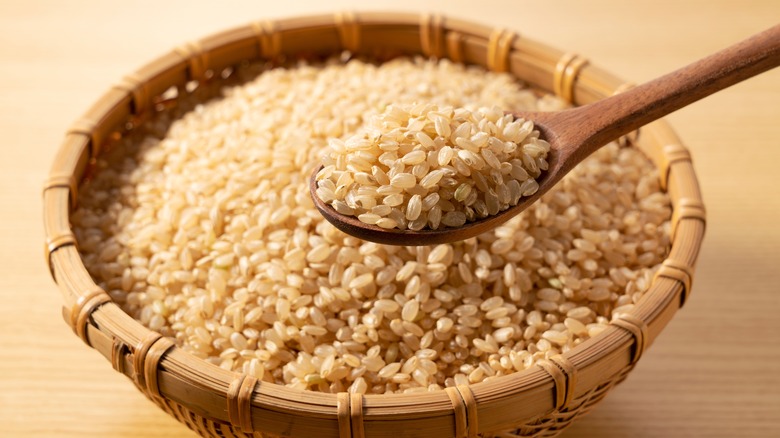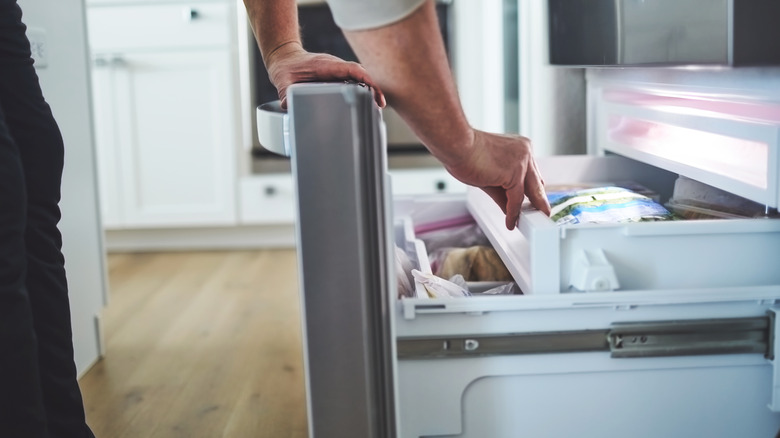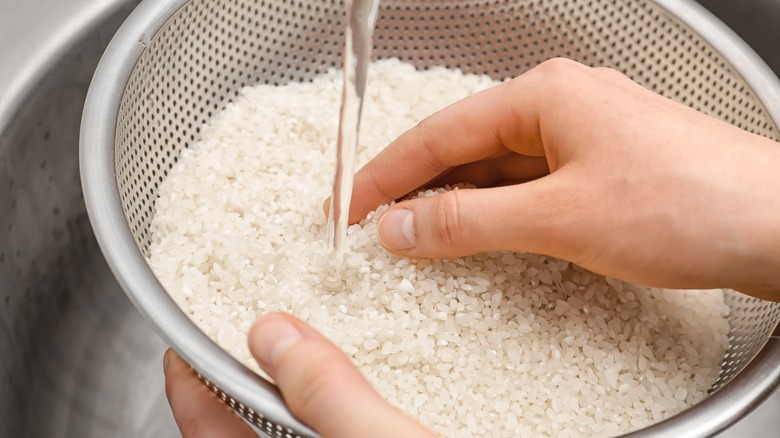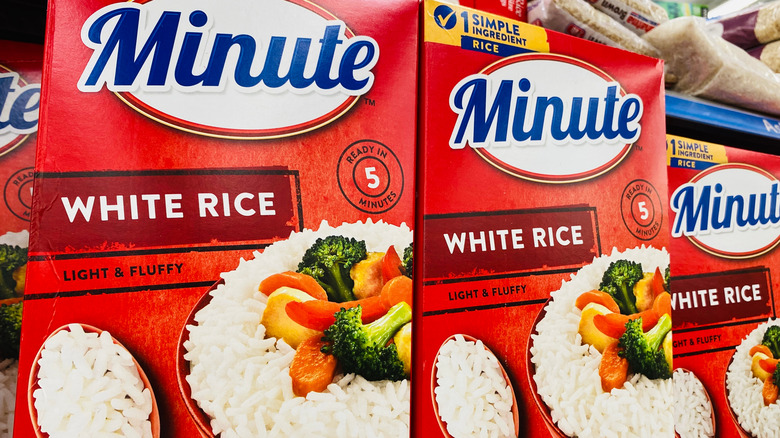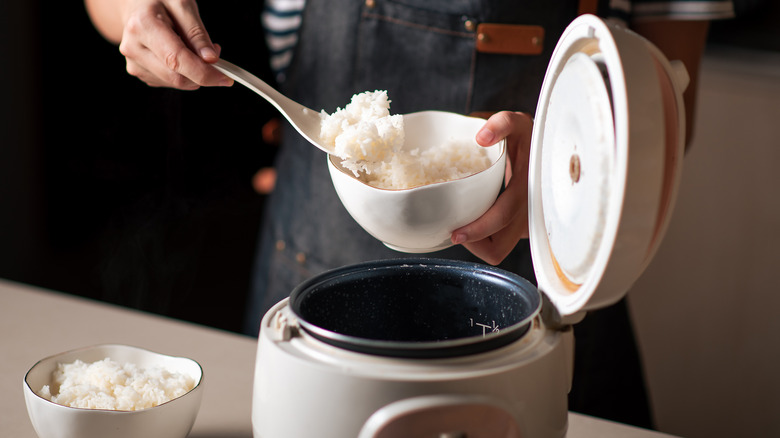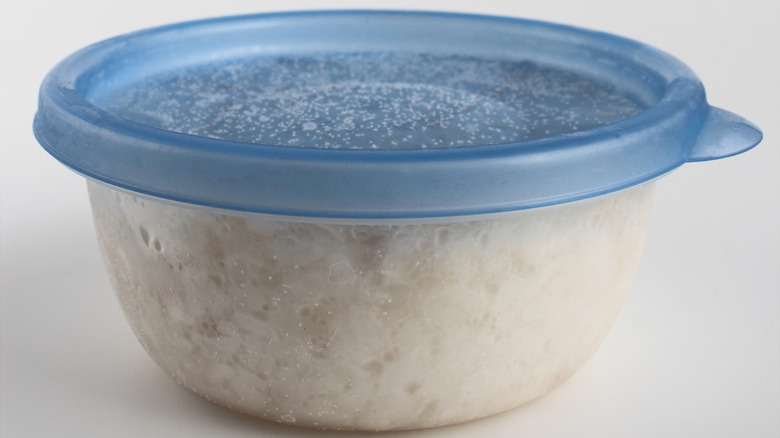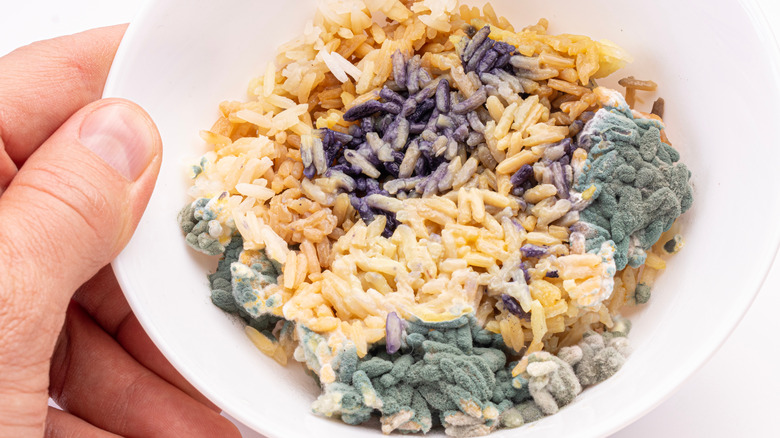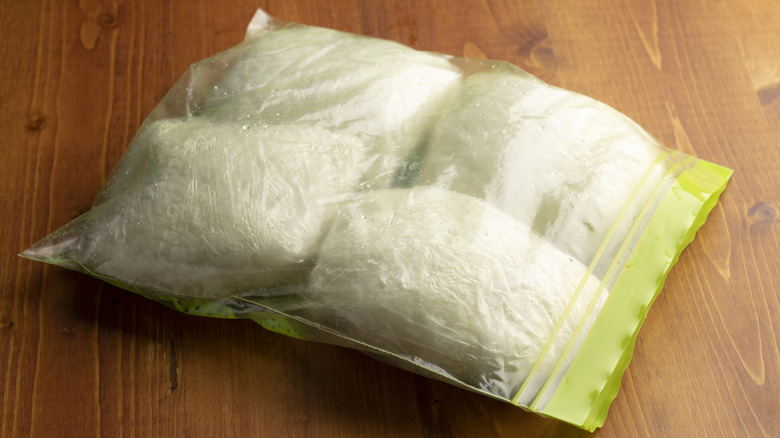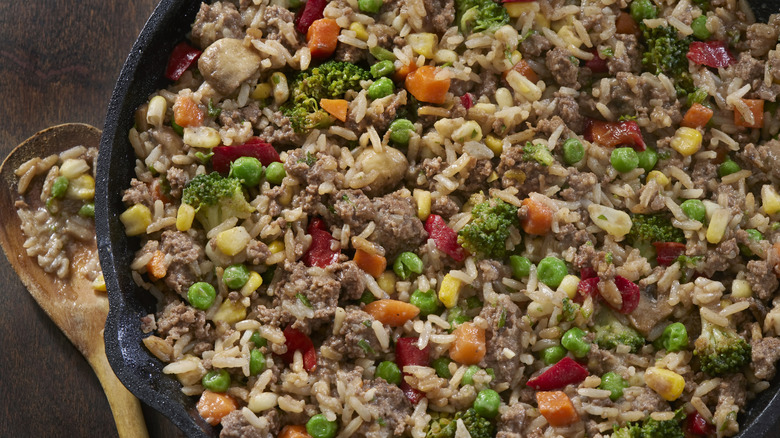Mistakes Everyone Makes When Storing Rice
Rice is a delicious, nutritious staple found in pantries and on dining tables around the globe. Just because plenty of people eat rice, though, doesn't mean we all know how to store it properly. There are a range of common errors people make when storing rice, both before and after it's cooked. These missteps can not only reduce your rice's shelf life, they can even be dangerous, so it's important to store your rice right.
When storing uncooked rice, you might be making mistakes such as not transferring it to a sealed container once the bag is open or storing it in direct sunlight. Once that rice is cooked, however, proper storage is arguably even more important. Eating leftover rice can be dangerous if you haven't treated it right, so you need to cool it quickly before storing it to avoid bacteria build-up. You also need to make sure you aren't keeping it for too long.
Now that we've touched on some potential pitfalls, we're ready to go into more detail. Let's uncover the biggest mistakes people make when storing rice — and highlight some practical solutions.
Storing uncooked rice somewhere that's too warm
You may think that uncooked rice is basically indestructible and that where you store it doesn't really matter, but this can easily turn into the basis of a mistake home cooks make all the time: storing rice somewhere that's too warm. While dried rice is generally fine stored at room temperature, it's best if that room is on the cooler side.
If you can, store your rice somewhere that's between 55 and 60 degrees Fahrenheit, but any kitchen cabinet or pantry should be fine. The temperature is usually lower in the back of a dark cabinet than it is in the rest of the room, so your rice might be cooler in there than you realize. The main factor is to keep the grains away from excessive heat, as this can cause rice to spoil more quickly. So, don't keep it in a cabinet that's right next to your cooker, or it might end up getting too warm.
Not using an airtight container for open bags of rice
Before you open a new bag of rice, it's tightly sealed. This keeps oxygen out, which is important since oxygen is responsible for speeding up rice's degradation process. But a sealed package doesn't just keep oxygen at bay — it also keeps moisture from getting in the bag and keeps out pests like weevils.
But what about after you've opened the bag? You may be tempted to just shove it back in the pantry or seal it with an elastic band and hope for the best. What you should really do after opening your rice, though, is transfer it to an airtight container. Options include Mason jars or other sealed food storage containers, so you probably already have something suitable. If you're unsure whether to opt for a glass or plastic storage container, there are some differences you should consider. Whatever container you opt for, though, it'll keep your rice fresh for longer.
Storing dry rice in direct sunlight
If you're storing your rice in direct sunlight, it won't last as long as if you stored it somewhere tucked away. Sure, it might look cute sitting in a Mason jar on your countertop or an open shelving unit, but light exposure will make it spoil faster. That's why you should keep it away from the sun's rays — ideally somewhere totally dark, like a kitchen cabinet or closed pantry. If this isn't possible in your home, choose an opaque container to store it in, as this will also block out sunlight.
Even if it doesn't make your rice go bad prematurely, light accelerates the process of degradation. Even before it's fully spoiled, you might notice changes in the taste and texture of any rice that's been exposed to light for too long. So, if you've noticed changes like these in your rice and aren't sure what the problem is, sunlight exposure might just be the answer.
Keeping uncooked rice for too long
Rice is the sort of thing that you see piled high in emergency food storage facilities and preppers' bunkers — that means it can basically survive the apocalypse, right? While dry rice does last a long time, it's not completely indestructible, so it might be time to consider throwing out that rice you've had in your pantry since 2020.
There's also a big difference between white rice and brown rice. White rice has been milled to remove each grain's bran and germ layers. This rice has been stripped of its natural oils, so there isn't much about it that can spoil. When stored in a cool, dry place in an airtight container, white rice can last four to five years (or even longer) without any significant loss of quality. In fact, even The USA Rice Federation says that it can last practically indefinitely.
Brown rice retains its bran and germ layers, which contain natural oils that can lead to quicker spoilage compared to white rice. As a result, brown rice has a shorter shelf life. When stored in similar conditions as white rice, brown rice usually lasts for about six months — up to a year at most — before it starts to taste bad or become rancid.
Not storing dry brown rice in the fridge or freezer
Even if you now know that brown rice only lasts about six months in a cool, dark pantry, you still may make another frequent mistake: not storing your uncooked brown rice in either the fridge or freezer. By storing it chilled or frozen, you can significantly increase its shelf life, so if you're the kind of cook who only reaches for a bag of brown rice once or twice a year, you may want to rethink your storage options to avoid waste.
You might be wondering if this storage tip really makes all that much difference. The short answer is yes; uncooked brown rice can last for 12 to 16 months in the fridge and around two years in the freezer. There are many types of rice out there, and some people recommend storing quality Arborio or carnaroli rice in the fridge, as well. Whether or not you think your dry brown rice is worth the fridge or freezer space is up to you, but fortunately, white rice can last much longer at room temperature.
Failing to check rice for pests
If your bag of rice has been around for a while, make sure you check it for pests before cooking, particularly if it's been opened and not transferred to an airtight container. Insects such as rice weevils, flour beetles, and meal moths are among the most common pests that can infest stored rice. Mice will also happily chow down on it, though this kind of infestation will likely be quite obvious. That's why insects are what we're looking for here.
Before you get started, inspect your rice's packaging and contents for signs of pests. Look for live insects, larvae, or droppings. If you have a serious infestation, it'll probably be easy to spot any insects inside your rice. If you're still worried, though, try putting some rice in a mesh sieve and shaking it over a piece of white paper for 20 to 30 seconds. If there are any bugs inside, they'll drop out and you'll spot them on the paper below. Rinsing rice can also help you spot weevils and other pests, as they float to the top.
If you store your rice correctly, you shouldn't have any problems with pests; however, it's still worth checking intermittently, particularly if you're storing rice for long periods. Over time, food packaging can develop tiny holes large enough for insects to pass through, and rice can occasionally be infested with insects when you buy it from the store.
Keeping instant rice past the use-by date
The best-by date on dry rice is more of a guideline than something to worry about. As long as you use brown rice within the recommended timeframe of six months (or one to two years if refrigerated or frozen) and store your white rice correctly, you can use your judgment. Instant rice, however, is a different matter, and you should definitely heed its printed date.
Instant rice — also known as quick-cooking rice or minute rice — has already been precooked or partially cooked. It's designed to cook much faster than traditional varieties, so it's convenient for quick meals or when you need to save time in the kitchen. This precooking might save you time, but it means that the rice is less shelf-stable than its dry counterparts. As such, it's best to toss it once its use-by date passes. Sure, it might be fine within a few weeks (or even a few months) of its printed expiration, but you shouldn't use it years after it's expired like you can with uncooked white rice.
Letting cooked rice sit out before storing it
It's important to cool cooked rice quickly before storing it in the fridge. This minimizes the risk of bacterial growth that can lead to food poisoning, per the USDA. So, if you don't want to spend a day getting overly acquainted with the toilet, make sure you cool and refrigerate your leftover rice as quickly as possible. You first need to lower it to a refrigerator-safe temperature of 40 degrees Fahrenheit, after which you can move it to the fridge to stay cool.
Rice shouldn't be left at room temperature for more than two hours, but if you can, it's best to cool it even quicker. One method is to transfer the cooked rice to a shallow, wide container or baking sheet. Spreading the grains out in a thin layer helps them cool more quickly because it increases the surface area that's exposed to the air. Alternatively, if you have a large amount of cooked rice, divide it into smaller portions before cooling, as these will cool quicker than a large batch. You can also place your container of cooked rice in a larger container filled with ice water. Stirring the rice occasionally will help cool it down more rapidly.
This doesn't mean you should be scared of reheated rice, though. If you cool your rice properly, it shouldn't give you any trouble; however, when you're preparing the leftovers, make sure to heat the rice thoroughly to kill any bacteria present.
Not storing cooked rice in an airtight container
How should you be storing your cooked rice in the fridge? The short answer is an airtight container. The long answer is that an airtight container reduces the cooked rice's exposure to bacteria and other contaminants present in your refrigerator. This extends the rice's shelf life and reduces the risk of foodborne illness.
What's more, these containers also create a sealed environment that prevents rice from absorbing any unwanted fridge smells. Cooked rice also tends to lose moisture when exposed to air, which can easily make leftovers a bummer. Storing your rice in an airtight container lets it hold onto its moisture, leaving it soft and fluffy longer.
You can use various containers to store cooked rice in the fridge. Designated food storage containers with tightly fitting lids are the obvious choice; however, you can also use zippered freezer bags, which are particularly convenient for storing smaller portions of the staple. Squeezing out excess air before sealing will also reduce contact with oxygen and help keep your rice fresh.
Keeping cooked rice in the fridge for too long
Even if you stored your cooked rice perfectly, it's still a mistake to keep it in the fridge for too long. Food spoilage is caused by the growth of microorganisms like bacteria, mold, and yeasts. These organisms are everywhere — some are even good for us or make foods like cheese taste good — but when they increase in numbers, food starts to go bad. While low temperatures slow this growth, the microorganisms will eventually reach dangerous numbers, even if you keep your food in the fridge.
Rice lasts roughly four to six days in the refrigerator. This may be impacted by factors like your refrigerator's internal temperature and how long the rice was left out before storing. Fortunately, there are several signs that cooked rice has gone bad. Primarily, like many spoiled foods, it will probably smell bad. Leave it longer and you might start to notice mold growth. Cooked rice can also dry out in the fridge over time. It isn't necessarily unsafe to eat just because it's dry, but this will ruin the texture of reheated rice, even if you add some extra water to rehydrate it.
Not using the freezer to keep cooked rice fresh for longer
Have leftover cooked rice that you're not realistically going to eat in the next four to six days? You should probably freeze it. This will preserve its texture, and after a short stint in the microwave, you can have your leftover rice on the table in just a few minutes. This makes it great to have on hand for weeknight dinners. You can also fry it from frozen to make quick and easy fried rice.
The process of freezing is simple. Start with rice that you've cooled quickly, the same way you would if you were going to store it in the fridge. If you have a large quantity, you might want to divide it into smaller portions based on your needs. This will make it easier to thaw and reheat only the amount you need for a meal. Next, choose a freezer-safe container (or a resealable freezer bag) for storing your rice. Fill the container with the portioned rice and label each one with the contents, as well as the date of freezing. This will help you keep track of how long it's been frozen, meaning you can be sure you're using the rice within a safe time frame. Now, all that's left is to put the containers in the freezer. It's best to use it within six months — it will still be safe for some time after, but the taste and texture might not be ideal.
Storing reheated rice
If you've been reheating your rice, then cooling any remaining leftovers and storing them in the fridge or freezer, you're making a mistake. Ideally, you should only reheat rice once. Reheating it multiple times increases the risk of dangerous bacterial growth (and the foodborne illnesses that can accompany it). Even if you cook it well, rice can contain bacteria that survive the heat of cooking, so it's not worth messing with.
When you have leftover rice in the fridge or freezer, try to only reheat the amount that you're going to eat in one sitting. Leave the rest chilling for next time. This reduces waste, as well as the temptation to freeze or refrigerate rice that's already been reheated once. If you accidentally reheat too much rice, don't be afraid to throw the excess in the trash. While food waste certainly isn't ideal, your health is way more important.
